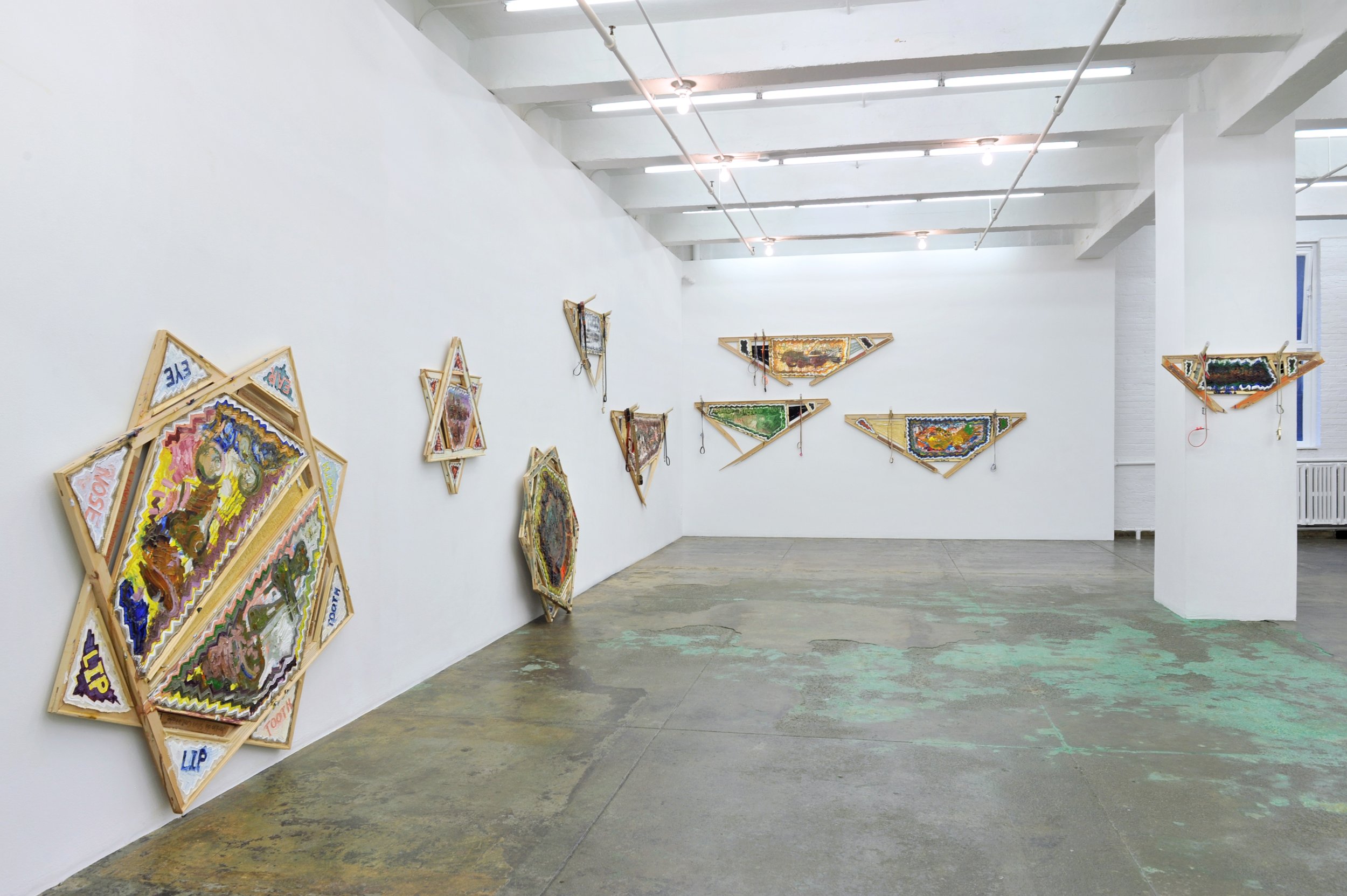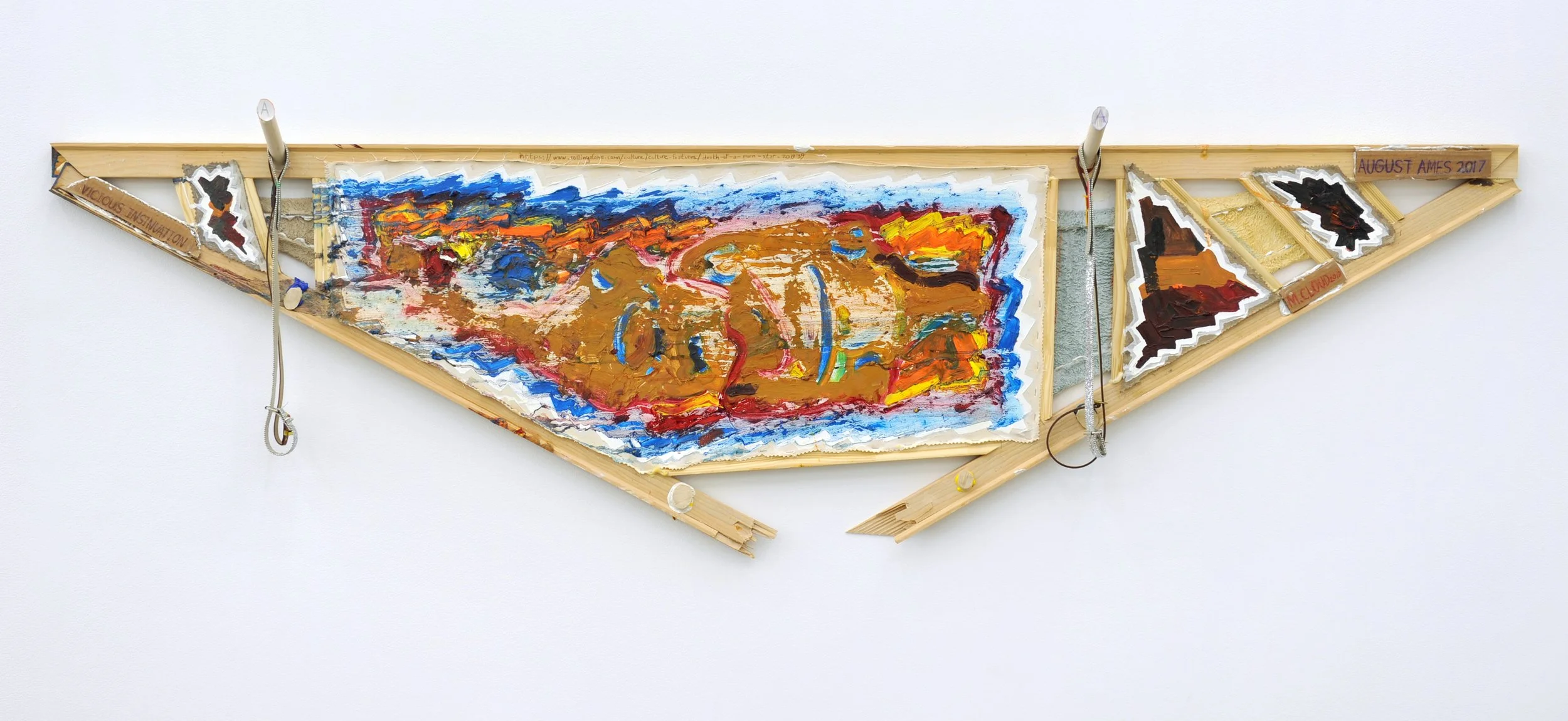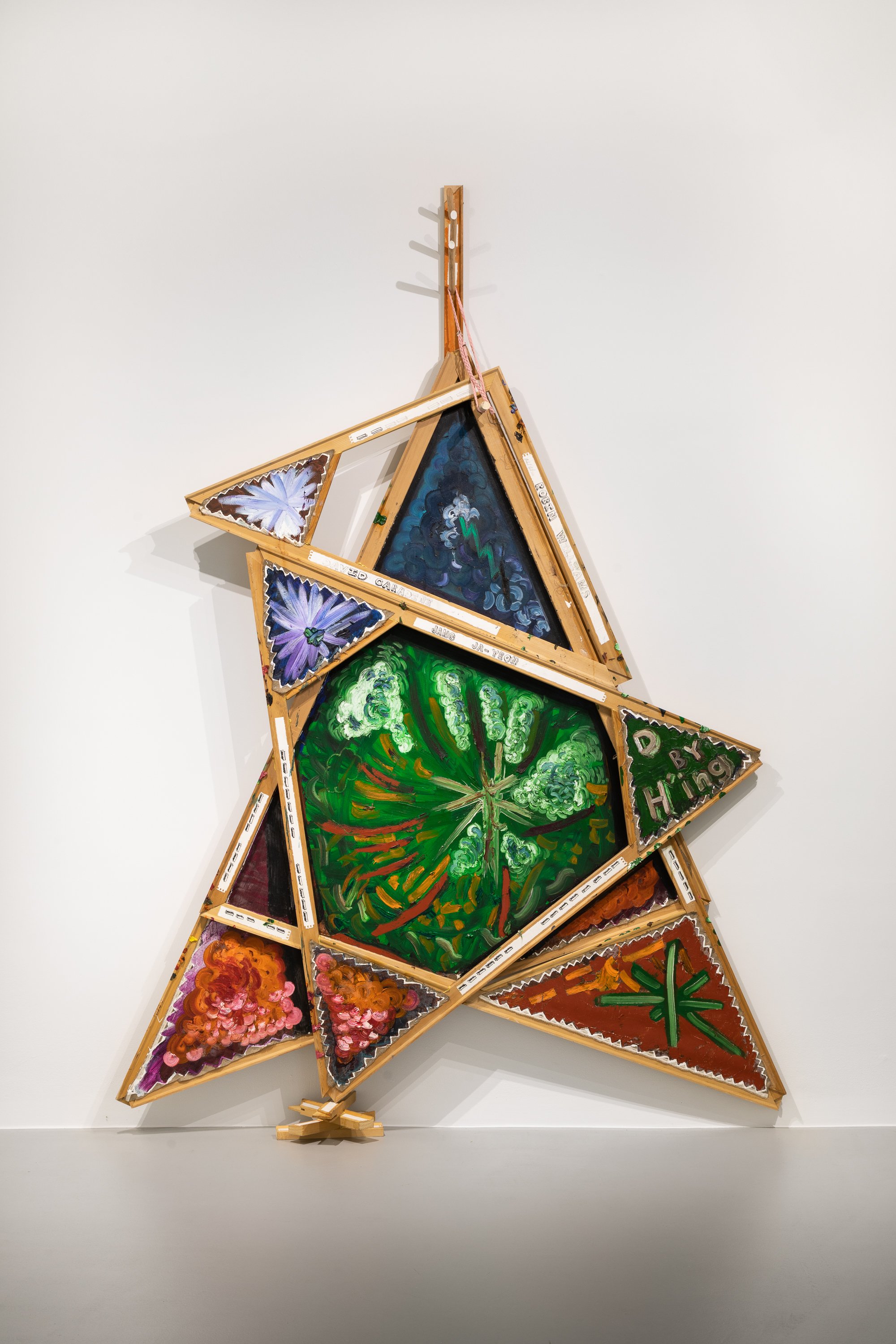Mike Cloud
The artist amongst his work.
BIO
Mike Cloud is an American painter living and working in Chicago, Illinois. He earned his M.F.A. from Yale University School of Art and his B.F.A. from the University of Illinois-Chicago. His work has been exhibited nationally and internationally at P.S.1, NY; the Studio Museum in Harlem, NY; Danubiana Meulensteen Art Museum, Slovak Republic; Honor Fraser Gallery, CA; Thomas Erben Gallery, NY; Good Children Gallery, LA; Marianne Boesky Gallery, NY; White Columns, NY; Max Protetch, NY; Apexart, NYC. Cloud has been reviewed in the New York Times, Art in America, Art Review and featured in the publication Painting Abstraction by Bob Nickas, published by Phaidon Press. His awards include the inaugural Chiaro Award from the Headlands Center for the Arts, an artist Fellowship from the New York Foundation for the Arts, the Barry Schactman Prize in Painting from the Yale University School of Art as well as the Grace Holt Memorial Award in African American Issues from the University of Illinois, Chicago. His work is held in private and public collections including The Bronx Museum (New York, NY), Lincoln Center (New York, NY) and the Metropolitan Museum of Art (New York, NY). Cloud has lectured extensively on his work and contemporary theoretical art issues at the Jewish Museum, Mason Gross School of the Arts at Rutgers University, Yale University, Cooper Union, Bard College, Kansas City Art Institute and the University of New Orleans. He is currently an associate professor at Northwestern University.
Installation view, Tears in Abstraction, west and north walls, 2019. Courtesy of the artist and Thomas Erben Gallery.
ARTIST STATEMENT
Paintings are always objects within a system of objects. My paintings are firmly anchored in the contemporary life of reproduction, symbolism, and description. My paintings aestheticize their subjects and function on social and political terms that go beyond the stakes of authentic expression. Through my work, I interrogate the politics, contrivances and language of painting in order to locate my complicity in its system of functions.
I employ a wide range of marks, symbols, motifs, palettes and forms in an expressive, wet-on-wet technique that blurs and blends elements together into compositions. This explosion of marks and gestures infuses my painterly surfaces with a playful, spirited abstractness. Painterly gestures and symbols combine with sculptural layers of wood, cloth, paper and other recognizable materials to emphasize the art object’s literal and material origin. The painting’s construction preserves its commoditized dimension and upends conventional, illusory space, producing a politic that pushes away from the surface and intrudes into our world.
I work with store-bought materials that I assemble into fractured shapes and unconventional pictorial spaces. I use painting’s sacred position on the wall to suggest an uncanny relationship to the form of the mirror, the window, the door and the shrine.
My practice, which encompasses an expanded field of painting and image making, dissects photographic and painterly form, scrambling text and re-aligning content in a way that produces new breaks in legibility and new understandings. My work combines an analytic approach with my interest in the conditions of history and the broader social sphere.
Ames 2017, 2019. Oil on canvas with mixed media, 96 x 26 in. Courtesy of the artist and Thomas Erben Gallery.
Interview with Mike Cloud
Questions by Andreana Donahue
Bourdain 2018, 2019. Oil on canvas with mixed media, 97 x 40 in. Courtesy of the artist and Thomas Erben Gallery.
Hi Mike! Over the years you’ve lived in Chicago and NYC, as well as New Haven during your time at Yale. How has working in these respective art communities supported or otherwise shaped your studio practice?
The community I am in dictates the content of my work. When I look at Dutch still life paintings I learn a lot about Dutch culture of a certain moment. I make my work in conversation with the culture of this moment. The content of my work is entirely social, and is entirely dictated to me by a social context outside of my control. New Haven during 9-11, New York during the financial crash and Obama presidency, Chicago during the aftermath of the George Floyd murder.
The connection between my work and this moment is what makes my work rhetorically and critically nutritious. It gives me aesthetic nutrition too, all art work does, but what makes my work different from going to a museum is how it embodies what I am learning and consuming every day. It is like an ideological owl pellet.
I am too squeamish to fully interrogate the racial, social and political contents of my work. Making the work feels so natural and interrogating it or interpreting it feels so unnatural. I am reluctant to understand it. I agree with Susan Sontag (against interpretation) and Nihilism in general in that regard: I feel that understanding is an unnecessary violence I do to the work of art.
I live in a secular, liberal society. I can do what I like, but I am not interested in exerting control over the ideological content of my work. I let my community do that. I exert a lot more control over the material form my work takes.
Red Triangle Geometric Quilt, 2007. Oil and clothes on canvas with stretcher bars, 104 × 101 in. Photo by Joseph Hu. Courtesy of the artist, the University of the Arts, and Thomas Erben Gallery.
You typically work from a repertoire of shaped canvases—six, eight, or twelve-pointed stars, coffins, arrows, and irregular “coat racks”, among others. In the past you’ve remarked, “I have a myth that I tell myself, that if I can make the painting the correct sort of object, it won’t really matter what I paint on it.” Can you talk more about this idea and your process of building a painting?
If I am being thorough, I have to say that the process of building my paintings begins with my motivation. It might start with a good motive like empathy, generosity or courage or it might start with a negative motive like fear, jealousy or greed. I honestly don't know if my artistic motives are, on the average, good or bad. They come and go. But having a motive is the first step in the process of building a painting.
The next step is having a reasonable, technical intention to make a painting of a particular size and shape; out of particular materials. The size and shape is unfixed because I can alter them late in the game by doubling or tripling simple shapes along the wall or stacking them outwards away from the wall until they become sculptural. I also use assemblage to incorporate different types of fabrics, woods and pigments into the painting at any time. My paintings are never as fluid or fractious as my emotional motives but my process is designed to approximate on one level what in fact occurs on another.
The last step in my process depends on what my rhetorical intentions are. When I intend to express myself I simply open up and work. When I have a particular narrative moment I struggle to illustrate it. When my intentions are memetic I choose a model and copy it. When they are formal I select passages from my aesthetic book of tricks and compose them across the canvas. Since my paintings are often composed of more than one canvas put together, they easily accommodate multiple intentions at once.
Shape is a manifestation of my intention to make a particular thing. Shape is a static visual foundation that contextualizes all my other visible decisions. Rectangles and squares are too stable. They ally themselves to the doors, walls and windows of architectural spaces and become even more stable. Shaking that foundation, weakening it, allows color, surface, and sign to fill in the cracks and take on a structural role in my work.
Cantanheade Portrait, 2019. Oil on canvas, 70 × 70 in. Photo by Joseph Hu. Courtesy of the artist, the University of the Arts, and Thomas Erben Gallery.
Rather than shy away from, you fully embrace the Star of David’s loaded meaning and history as a symbol of Jewish identity. Can you talk about the origin of the Star of David in your work?
There are two rival street gangs in Chicago where I grew up. One uses, if I recall correctly, the Star of David as their symbol and the other uses a pyramid (both symbols I also use in my work). Their use of the symbolism mirrors conflict in the Middle East. I doubt that is their intention, but there are reasons both cultural and aesthetic, why their symbols are not, say a smiley face and playboy bunny ears.
The Shoa introduced me to the concept of the “survivor” as an alternative to the winner and the loser in conflict. Art history books were, in my youth, unapologetically titled “Art since 1945” (the end of World War Two), the bombing of Hiroshima and the publishing of images from Auschwitz and Dachau were milestones on our road to the Postmodern Condition. There are, as far as I know, no modern armies marching into armed conflict under the sign of the Christian Crucifix, but the star of David is still a very real political sign. Rainbow flags featuring The Star of David are still regularly banned from gay pride parades across the U.S.
My paintings are obviously political. I use them to describe my political reality even as I use them to design a completely original, hermetic, pictorial reality. The politics of my painted realities are only legible because I use political signs like the star of David, the gay pride flag, etc. My painted realities go beyond the purely sensual and move into the proper social, cultural and political.
I could simply paint sensual spaces of color and shape without any determinant content. After all, why make the space of my paintings social or political spaces when I already inhabit a space of that sort every day? Why not make it a clean, pure emotional space? Or a space of fantasy and empowerment? I guess the reason is because if I painted clean, pure emotional spaces it would become a place for me to retreat from all the complexities of real space and my own failures.
I incorporate historical and social negativities like racism and war, and existential negativities like death and failure, because my painted spaces are not safe spaces, places of refuge or retreats for me. My paintings are places of fruitful, applicable contemplation. places where I experience the complexities of real space under the particular circumstances of painted space.
Shopping List Greener Pastures, 2020. Oil on linen with mixed media, 67 × 116 in. Photo by Joseph Hu. Courtesy of the artist, the University of the Arts, and Thomas Erben Gallery.
In many of your paintings hand-written URLs are legible - a viewer may or may not visit them to access information on subjects ranging from mass genocide to puppy adoption. Can you give some insight into the inclusion of this text? What are your thoughts on the constant presence of (or distraction posed by) screens in our current culture?
I mix drawing and technology in my work through text that is either appropriated from very contemporary sources or made to feel appropriated. I draw more expressively and authentically than I write. My handwriting is something I was strictly taught and made to practice over the years. It was never a private project like drawing was. Text in my paintings appears as captions, poems, titles, and URLs to reference mediums outside of painting like print, film and the internet.
Screens and the internet are referenced through my use of the URLs and also my use of fluorescent, iridescent and metallic colors. But the basic thing I want to borrow from my computer and place in my paintings is the information that moves and changes, and my paintings don’t really do that. The computer screen is something of an aesthetic dead end for me. The proliferation of screens in my everyday life doesn't bother me. Video and film dominate my aesthetic life at the moment, not text. Clips and gifs rather than URLs.
F of J, 2016. Oil on linen, 90 × 80 in. Photo by Joseph Hu. Courtesy of the artist, the University of the Arts, and Thomas Erben Gallery.
Your work reflects an ongoing interest in Native American spirit wheels, cosmograms, prehistoric cave paintings, and shrines. In what ways do these ancient forms and practices inform your paintings?
My paintings are cosmograms. Like the spirit wheel, it is simultaneously mapping things close and transcendently beyond. I make paintings that are intensely, profoundly symbolic. They are signs that point to the world that is beyond my ability to picture but not beyond my ability to imagine. They are inline with American folk cosmograms, African cosmograms, hex signs and even crop circles.
I make unschooled images that anyone could make with paint and eyes and hands and a mind. I could make them with just my own lifetime’s store of knowledge, but their meanings are very cultured and beyond me as an individual. The meaning or as I said “content” is social and beyond my control as an individual. My technique is simple enough for me to execute alone without studio assistants or a decade of atelier training. I make what I can make but it points to a thing beyond myself. It is a sign that anyone can make that points to a collective thing beyond individual picturing but not beyond imagining.
Untitled, 2019. Oil on canvas, 60 × 60 in. Photo by Joseph Hu. Courtesy of the artist, the University of the Arts, and Thomas Erben Gallery.
Wan-Im, 2018. Oil on canvas, 51 × 51 in. Photo by Joseph Hu. Courtesy of the artist, the University of the Arts, and Thomas Erben Gallery.










